

 | |
Pillow basalts on the side of the volcano. | |
 | |
Pillow basalts from from inside the Pisces V. |
Recently, an interdisciplinary team that included faculty, students and research scientists from the University of Colorado, Scripps Institution of Oceanography, Oregon Graduate Institute, Stanford Synchrotron Radiation Lightsource and Pacific Northwest National Laboratory conducted a microbial colonization experiment at Loihi Seamount, adjacent to the Big Island of Hawaii. Young basaltic glasses were collected by the deep-sea submersible Pisces V and the remote operated vehicle Jason II to determine whether or not extensive biofilm formation and rock weathered had occurred. The study was designed to test whether bacteria were catalyzing the release of Fe(II) and Mn(II) from basaltic glasses and oxidizing these metals by reaction with oxygen in seawater to gain energy for growth. To date, exploring rapid changes in the chemistry of natural rock surfaces has been difficult due to the small length scales over which the reactions occur and the need to achieve chemical sensitivity. The team solved this problem using synchrotron-based x-ray fluorescence microprobe mapping coupled with x-ray absorption spectroscopy at SSRL Beam Lines 2-3 and 11-2 to explore the micron-scale changes in Fe and Mn distribution and chemical speciation at the rock/biofilm interface. The key measurements involved energy-difference mapping and the Fe K-edge to spatially resolve changes in the ratio of Fe(II) to Fe(III) across the reacted surfaces (see Figure 1).
 |
|
Figure 1. |
The study, recently published in Nature Geoscience (Templeton et al., 2009), also used newly developed focused-ion-beam milling techniques to cut into the surface of colonized rocks and extract sections of the biofilm/mineral interfaces for high-resolution scanning and transmission electron microscopy. Together, the combined spectroscopic and imaging data surprisingly revealed that the microbial biofilms are not inducing rapid weathering of the colonized basalts, nor oxidizing the Fe and Mn derived from the surfaces. Instead, the biofilms are mediating the uptake and oxidation of dilute carbon, Fe and Mn from seawater and building mineral crusts dominated by Fe(III) and Mn(IV)-oxyhydroxides. These findings suggest that basalts may often not be the energy source for seafloor life, and that many microbial communities may instead rely upon the dispersion of hydrothermal fluids through the deep ocean. In addition, the biomineralization reactions within the microbial biofilms appear to generate critical micron-scale precursors of highly-reactive "ferromanganese crusts". Previously, the growth mechanisms for ferromanganese crusts have been relatively enigmatic. However, this study provides new insights into the genesis of ferromanganese crusts, which ultimately become ubiquitous across the Pacific seafloor and accumulate economic concentrations of trace metals over geological time scales.
The National Science Foundation, the David and Lucille Packard Foundation, and a NASA Predoctoral Fellowship funded this research.
Primary Citation
Templeton, A.S., Knowles, E.J., Eldridge, D.L., Arey, B.W., Dohnalkova, A., Webb, S.M., Bailey, B.E., Tebo, B.M., Staudigel, H.S., 2009, A seafloor microbial biome hosted within incipient ferromanganese crusts. Nature Geoscience v. 2, p. 872-876.
SSRL is supported by the Department of Energy, Office of Basic Energy Sciences. The SSRL Structural Molecular Biology Program is supported by the Department of Energy, Office of Biological and Environmental Research, and by the National Institutes of Health, National Center for Research Resources, Biomedical Technology Program, and the National Institute of General Medical Sciences.